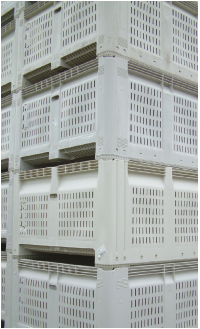
Features
Production
Research
‘Bin’ there, done that: Nova Scotia’s fruit industry contemplates shift to plastic bins
May 15, 2008 By Dan Woolley
The Nova Scotia Fruit
Growers’ Association’s board of directors is considering a report
outlining the pluses and minuses of converting the Nova Scotia fruit
industry from wooden bins to plastic ones.
 |
| Officials with the Nova Scotia Fruit Growers’ Association are considering shifting the Nova Scotia fruit industry from wooden bins to plastic ones. |
The Nova Scotia Fruit Growers’ Association’s board of directors is considering a report outlining the pluses and minuses of converting the Nova Scotia fruit industry from wooden bins to plastic ones.
The report, compiled by agriculture consulting firm Agra Point International, draws on the results of an industry survey, conducted among packers and growers, plus input from a bulk bin strategy workshop held during the NSFGA’s annual convention in January.
NSFGA staff member Helen Arenburg conducted the industry survey, to which 32 growers responded. Combined, those 32 growers own about 33,945 bins. Respondents estimate there is a current shortfall of 12,663 bins within the industry and a need to immediately replace 11,000 bins plus a further 8,000 within the next five years. As a replacement option, the survey stated, 19 growers prefer wooden bins while another 13 are opting for plastic.
Of the four packers surveyed, three said a shortage of bins hampered their intake of apples while the remaining packer said 50 per cent of the current bins need to be retired.
Of the 42 growers present at the bulk bin workshop, 23 believe the industry should change to plastic bins.
Tom O’Neill, general manager of the Norfolk Fruit Growers’ Association (NFGA), Ontario’s fourth largest pack house with just over one million bushels of storage capacity – 150,000 bushels in cold storage, 880,000 bushels in controlled-atmosphere and 80,000 bushels in common storage, knows a thing or two about wooden and plastic bins. From 1997 to 2002, he led his association’s transition from wooden to plastic bins.
It was an expensive endeavour, sparked by the rising cost of repairing and replacing wooden bins. In 1995, the NFGA replaced or repaired about 5,700 of its 66,000 wooden bin inventory at a cost in excess of $400,000 or about $70 per bin. The average age of the bins was 11.25 years.
O’Neill felt the association could no longer afford to fix its wooden inventory. Since the NFGA’s storage was built to accommodate wooden bins 42 inches by 48 inches and 30 inches high, the association decided to shift to a plastic bin 44 inches by 48 inches with a height of 34 inches. This enabled the group to reduce its bin numbers from 66,000 to 43,000.
 |
| Above: Currently, 32 growers and packers within the Nova Scotia fruit industry have about 33,945 wooden bins, with a shortfall of 12,663 bins within the industry and a need to immediately replace 11,000 bins and a further 8,000 within the next five years. Below: The Norfolk Fruit Growers’ Association (NFGA) transitioned to plastic bins from 1997 to 2002 due to the rising cost of repairing and replacing wooden bins. |
 |
Although they could only stack plastic bins eight high, compared to the nine high possible with wooden bins, the NFGA gained a six per cent increase in capacity in its controlled atmosphere storage as well as reduced freight charges for its growers, explains O’Neill. The group also reduced fruit damage, improved bin sanitation and achieved improved cooling efficiency with 29 per cent less time and fewer people required to move the crop into storage.
O’Neill also cites other benefits from shifting to plastic bins, including less deterioration of the bin from the sunlight and prolonged outdoor storage. The bins are also less likely to flex under load weight when being transported; have no rough surfaces, metal pieces or splinters that can damage the fruit; are 40 per cent lighter than wooden bins when wet, and have an interlocking foot design for easy alignment and stacking.
The NFGA repair its own plastic bins on site using a hot-air welder and available replacement parts at a significant cost reduction from wooden repairs. “We probably repair about 1,200 bins a year,” says O’Neill.
He estimates that about 20 per cent of Ontario’s apple industry, including all of the major packers, has switched to plastic bins. Most are being sourced from Macro Plastics, based in California, which is marketing a 32-inch-high injection-moulded plastic bin. “There is no one building plastic bins in Ontario,” says O’Neill.
Plastic bins are currently more expensive than wooden bins, largely due to $100-per-barrel oil. This has led to a 30 per cent increase in material costs for Macro Plastics, explains Mark Harley, the company’s national sales manager.
“(Growers) have to do what makes sense for (them),” he says. “Tom went at this very aggressively. The economics are different now.”
He suggests packers start small, transitioning to plastic in one storage room utilizing a standard bin size and a high-value fruit. He claims the value of plastic bins will increase 2.5 times over wood.
“They can be a balance sheet asset over time rather than a liability,” he says, adding they should last for 20 years. “They won’t wear out before they are damaged.”
If Nova Scotia growers do decide to shift to plastic bins, O’Neill recommends they put some thought into the process and standardize the bin size footprint across the industry. “An odd-size bin not only messes up a stack; it will mess up an entire row,” he explains.
Print this page